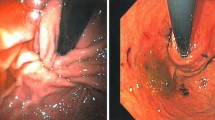Abstract
Background
Transoral incisionless fundoplication (TIF) using the EsophyX™ system has been introduced as a possible alternative for the treatment of gastroesophageal reflux disease (GERD). The efficacy of this procedure in our centers was evaluated.
Methods
Patients were selected for treatment if they had typical GERD symptoms, failed management with proton pump inhibitors (PPIs), a positive esophageal pH test with symptom correlation, and no hiatus hernia larger than 2 cm.
Results
Nineteen patients (11 men, 8 women) underwent the TIF procedure between April 2008 and July 2009. Mean age was 48.2 years and body mass index was 24.6. The major complication rate was 3/19, including esophageal perforation, hemorrhage requiring transfusion, and permanent numbness of tongue. At mean 10.8 months follow-up, 5/19 had completely discontinued PPIs, and 3/19 had decreased their PPI dose. However, 10/19 had been converted to laparoscopic fundoplication for recurrent reflux symptoms and an endoscopically confirmed failed valve. Nine of 17 were dissatisfied with the outcome, and eight were satisfied. Thirteen of 19 (68%) were considered to have been unsuccessful.
Conclusion
At short-term follow-up, the TIF procedure is associated with an excessive early symptomatic failure rate, and a high surgical re-intervention rate. This procedure should not be performed outside of a clinical trial.

Similar content being viewed by others
References
Importance of pH control in the management of GERD. Hunt RH. Arch Intern Med 1999;159:649–57.
Giannini EG, Zentilin P, Dulbecco P, et al. Management strategy for patients with gastroesophageal reflux disease: a comparison between empirical treatment with esomeprazole and endoscopy-oriented treatment. Am J Gastroenterol 2008;103:267–275.
Moayyedi P, Axon AT. Review article: gastro-oesophageal reflux disease—the extent of the problem. Aliment Pharmacol Ther 2005;22(Suppl 1):11–19.
Dallemagne B, Weerts J, Markiewicz S, Dewandre JM, Wahlen C, Monami B, Jehaes C. Clinical results of laparoscopic fundoplication at ten years after surgery. Surg Endosc 2006;20:159–165.
Papasavas PK, Keenan RJ, Yeaney WW, Caushaj PF, Gagne DJ, Landreneau RJ. Effectiveness of laparoscopic fundoplication in relieving the symptoms of gastroesophageal reflux disease (GERD) and eliminating antireflux medical therapy. Surg Endosc 2003;17:1200–1205.
Carlson MA, Frantzides CT. Complications and results of primary minimally invasive antireflux procedures: a review of 10,735 reported cases. J Am Coll Surg 2001;193:428–439.
Montgomery M, Hakanson B, Ljungqvist O, et al. Twelve months’ follow-up after treatment with the EndoCinch endoscopic technique for gastro-oesophageal reflux disease: a randomized, placebo-controlled study. Scand J Gastroenterol. 2006;41:1382–1389.
Torquati A, Richards WO. Endolumenal GERD treatments: critical appraisal of current literature with evidence-based medicine instruments. Surg Endosc. 2007;21:697–706.
Cicala M, Gabbrielli A, Emerenziani S, et al. Effect of endoscopic augmentation of the lower oesophageal sphincter (Gatekeeper reflux repair system) on intraoesophageal dynamic characteristics of acid reflux. Gut 2005;54:183–186.
Louis H, Deviere J. Endoscopic implantation of enteryx for the treatment of gastroesophageal reflux disease: technique, pre-clinical and clinical experience. Gastrointest Endosc Clin N Am 2003;13:191–200.
Jobe BA, O’Rourke RW, McMahon BP, et al. Transoral endoscopic fundoplication in the treatment of gastroesophageal reflux disease. Ann Surg 2008;248:69–76.
Cadiere GB, Buset M, Muls V, et al. Antireflux transoral incisionless fundoplication using EsophyX: 12-month results of a prospective multicenter study. World J Surg 2008;32:1676–1688.
Bergman S, Mikami DJ, Hazey JW, et al. Endolumenal fundoplication with EsophyX: the initial north American experience. Surg Inno 2008;15(3):166–170.
Demyttenaere SV, Bergman S, Pham T, et al. Transoral incisionless fundoplication for gastroesophageal reflux disease in an unselected patient population. Surg Endosc 2009;24(4):854–8.
Cadiere GB, Sante NV, Graves JE, et al. Two-year results of a feasibility study on antireflux transoral incisionless fundoplication using EsophyX. 2009;23:957–964
Repici A, Fumagalli U, Malesci A, et al. Endoluminal fundoplication (ELF) for GERD using EsophyX: a 12-month follow-up in a single-center experience. 2009;13:1–6.
Testoni PA, Corsetti M, Di Pietro S, et al. Effect of transoral incisionless fundoplication on symptoms, PPI use, and pH-Impedance refluxes of GERD patients. World J Surg 2010;34(4):750–7.
Pandolfino JE, Richter JE, Ours T, et al. Ambulatory esophageal pH monitoring using a wireless system. Am J Gastroenterol 2003;98(4):740–9.
Hill LD, Kozarek RA, Kraemer SJM, et al. The gastroesophageal flap valve: in vitro and in vivo observations. Gastrointest Endosc. 1996;44:541–547.
Schilling D, Kiesslich R, Galle PR, et al. Endoluminal therapy of GERD with a new endoscopic suturing device. Gastrointest Endosc 2005;62:37–43.
Swain P, Park PO. Endoscopic suturing. Best Pract Res Clin Gastroenterol 2004;18(1):37–47.
Conflict of Interest Statement
In August 2008 Andrew Smith and David Watson received support from Endogastric Solutions (Australian distributor for the EsophyX™ device) for travel from Australia to Seattle for training in the TIF procedure. The training was provided by Endotherapeutics. Blair Jobe underwent procedure training in Seattle at the Endogastric Solutions facility. Along with Stefan Kraemer, the device inventor, Dr. Jobe developed the TIF 2.0 procedure and this approach was validated within a preclinical study funded by Endogastric Solutions.
Author information
Authors and Affiliations
Corresponding author
Rights and permissions
About this article
Cite this article
Hoppo, T., Immanuel, A., Schuchert, M. et al. Transoral Incisionless Fundoplication 2.0 Procedure Using EsophyX™ for Gastroesophageal Reflux Disease. J Gastrointest Surg 14, 1895–1901 (2010). https://doi.org/10.1007/s11605-010-1331-7
Received:
Accepted:
Published:
Issue Date:
DOI: https://doi.org/10.1007/s11605-010-1331-7




